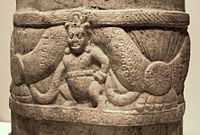Yaksha

Yaksha (Sanskrit: यक्ष yakṣa)[1] is the name of a broad class of nature-spirits, usually benevolent, who are caretakers of the natural treasures hidden in the earth and tree roots.[2] They appear in Hindu, Jain and Buddhist literature.[2] The feminine form of the word is yakṣī (यक्षी)[3] or Yakshini (yakṣiṇī, यक्षिणी).[4][5]

In Hindu, Jain, and Buddhist texts, the yakṣa has a dual personality. On the one hand, a yakṣa may be an inoffensive nature-fairy, associated with woods and mountains; but there is also a darker version of the yakṣa, which is a kind of ghost (bhuta) that haunts the wilderness and waylays and devours travelers, similar to the rakṣasas.
In Kālidāsa's poem Meghadūta, for instance, the yakṣa narrator is a romantic figure, pining with love for his missing beloved. By contrast, in the didactic Hindu dialogue of the Yakṣapraśnāḥ "Questions of the Yakṣa", it is a tutelary spirit of a lake that challenges Yudhiṣṭhira. The yakṣas may have originally been the tutelary gods of forests and villages, and were later viewed as the steward deities of the earth and the wealth buried beneath.
In Indian art, male yakṣas are portrayed either as fearsome warriors or as portly, stout and dwarf-like. Female yakṣas, known as yakṣiṇīs, are portrayed as beautiful young women with happy round faces and full breasts and hips.
Yakṣas in Buddhism

In Buddhist literature, the yakṣa are the attendants of Vaiśravaṇa, the Guardian of the Northern Quarter, a beneficent god who protects the righteous. The term also refers to the Twelve Heavenly Generals who guard Bhaiṣajyaguru, the Medicine Buddha.
According to the Mahavamsa, Prince Vijaya encountered the royalty of the Yakkhas. King Maha Kalasena, Queen Gonda on the celebration of the marriage of their daughter Princess Polamitta in the Yakkha capital of Lankapura and conquered them. Lankapura may have been in Arithra or Vijithapura. The Yakkhas served as loyal subjects with the Vijiyan dynasty and the Yakkha chieftain sat on equal height to the Sri Lankan leaders on festival days.
Thailand
Yakshas (Thai: ยักษ์, Yak) are an important element in Thai temple art and architecture.[6] They are common as guardians of the gates in Buddhist temples throughout the country since at least the 14th century. Ceramic sculptures of guardian Yakshas were produced in Thailand, during the Sukhothai and Ayutthaya periods, between the 14th and 16th centuries, at several kiln complexes located in northern Thailand.[7] They are mostly depicted with a characteristic face, having big round bulging eyes and protruding fangs, as well as a green complexion. Yakshas and their female counterparts are common in the Buddhist literature of Thailand. As ogres, giants and ogresses yakshas are popular as well in Thai folklore.
"ย ยักษ์", (yo yak) is also used as an illustration in order to name the letter ย, the 34th consonant of the Thai alphabet, according to the traditional letter symbols Thai children use to memorize the alphabet.[8]
Yaksha and Yakshini in Jainism
Jains mainly worship idols of Arihants and Tirthankaras, who have conquered the inner passions and attained God-consciousness status. Some Jains also believe that Yaksha and Yakshini look after the well-being of Tirthankaras. Usually, they are found in pair around the idols of Jinas as male (yaksha) and female (yakshini) guardian deities. Yaksha is generally on the right-hand side of the Jina idol and Yakshini on the left-hand side. In earlier periods, they were regarded mainly as devotees of Jina, and have supernatural powers. They are also wandering through the cycles of births and deaths just like the worldly souls, but have supernatural powers. Over time, people started worshiping these deities as well.[9]
Some sections of Jains looked at yaksas and yaksanis for the immediate returns, and gave them the places in their temples. Some Yaksa were and are known for bestowing fertility and wealth upon their devotes. Therefore, they had become very popular and their idols had been placed in Jain temples and Jains worship them. Jains offer them different things in favor of boons for children, wealth or freedom from fears, illness or disease.[citation needed]
Jainism provides very clear foundations and guidelines, and it is up to every individual jains to decide which idols to worship and which ones that should just be acknowledged. Sthanakvasi and Terapanthi Jains of the Svetambara and Taranpanthi Jains of the Digambaras do not believe in idol worshiping.[citation needed]
Prominent Yakshas and Yakshanis
See also
Notes
- ↑ Equivalent terms in other languages include: Pali: यक्ख yakkha,(For yakkha as a "rare use in Pali" see Franklin Edgerton, Buddhist Hybrid Sanskrit Grammar and Dictionary, vol. 2., Motilal Banarsidass, First Edition, 1953, p. 442.) Tamil: யக்கர், Kannada: ಯಕ್ಷ, Yākka, Thai: ยักษ์ yaksa, Vietnamese: dạ xoa, Chinese: 夜叉 yèchā or 藥叉 yàochā, Korean: 야차/夜叉 yacha, Japanese: 夜叉 yasha, Burmese: ဘီလူး [bìlú], Standard Tibetan: གནོད་སྦྱིན་ gnod sbyin
- ↑ 2.0 2.1 "yaksha". Encyclopædia Britannica. Retrieved 2007-07-15.
- ↑ For यक्षी as the feminine of यक्षः see V. S. Apte, The Practical Sanskrit-English Dictionary, p. 776.
- ↑ For yakṣiṇī (यक्षिणी) as a regular Sanskrit term for a female yakṣa, and yakṣaṇī as a Buddhist variant, see Franklin Edgerton, Buddhist Hybrid Sanskrit Grammar and Dictionary, vol. 2., Motilal Banarsidass, First Edition, 1953, p. 442.
- ↑ In other languages: Pāli: yakkhī (यक्खी) or yakkhiṇī (यक्खिणी)).[citation needed]
- ↑ Thai temples
- ↑ Samuel P. Harn Museum of Art, Gainesville, Florida
- ↑ Thai alphabet in Letters
- ↑ Pramodaben Chitrabhanu, Jain symbols, Ceremonies and Practices
References
| Wikimedia Commons has media related to Yaksha. |
- Dictionary of Hindu Lore and Legend (ISBN 0-500-51088-1) by Anna Dhallapiccola
- Encyclopædia Britannica: Yaksha, EBC: Yaksha
| |||||||||||||||||
| ||||||||||||||||||||||||||||||||||||||||||||||||||||||||
